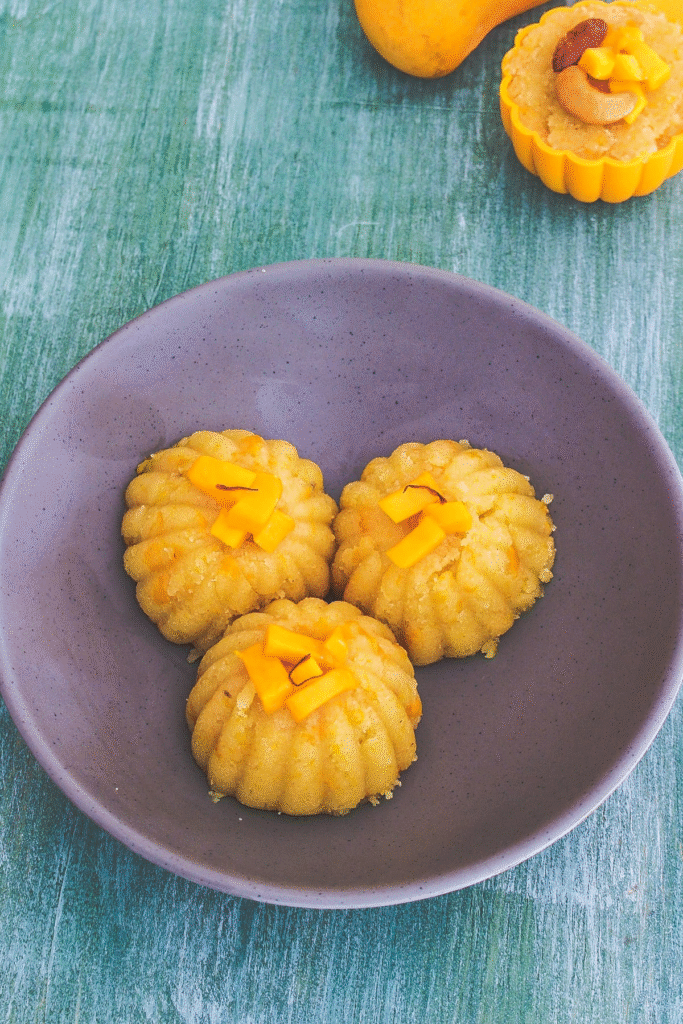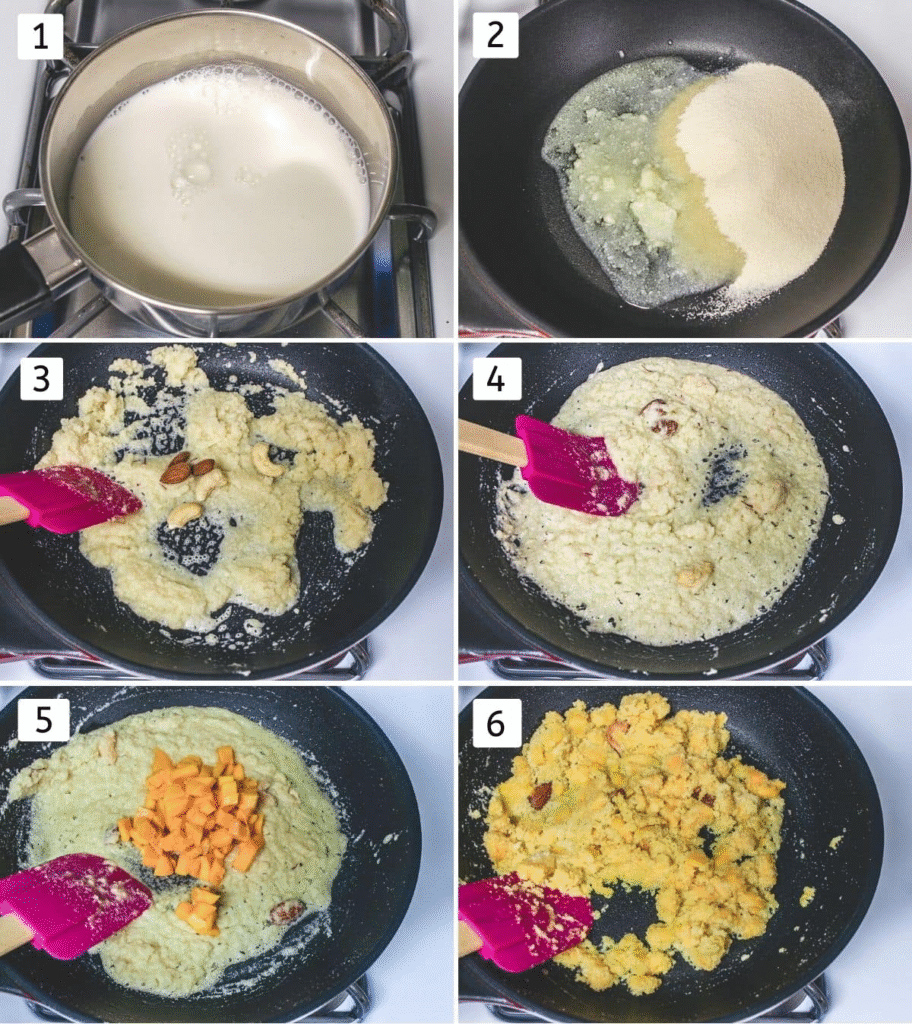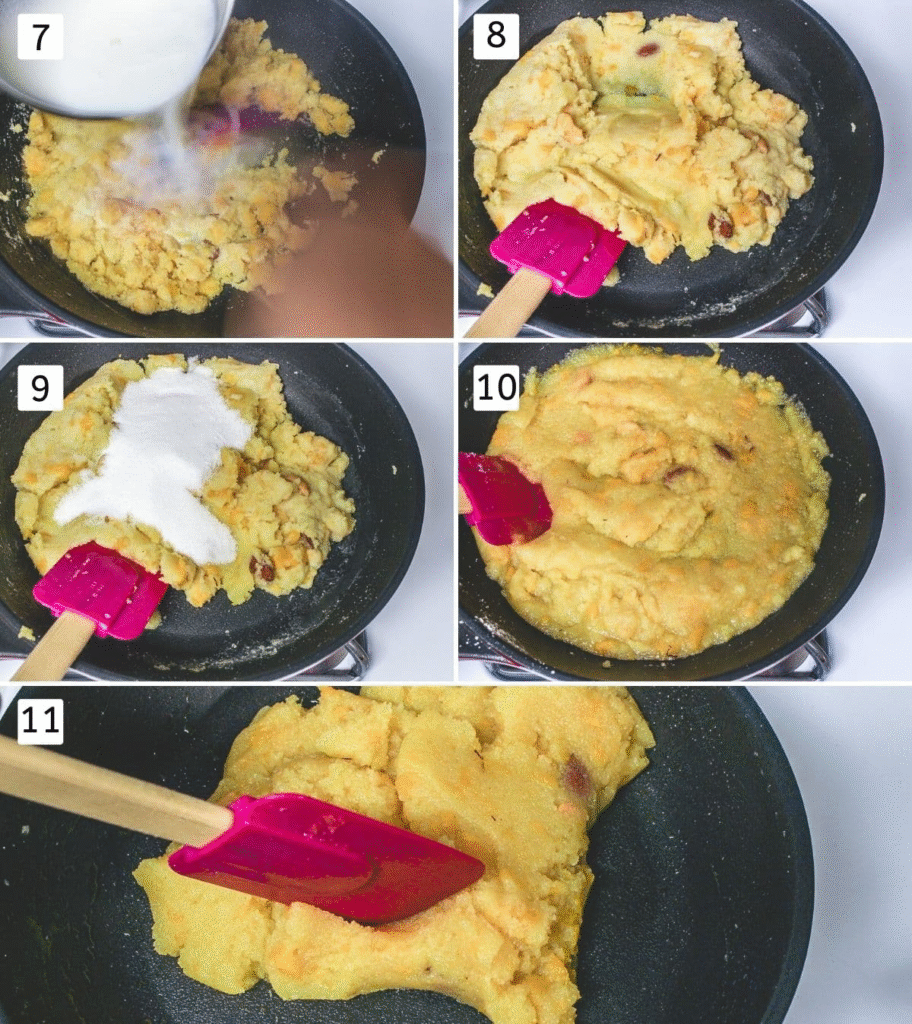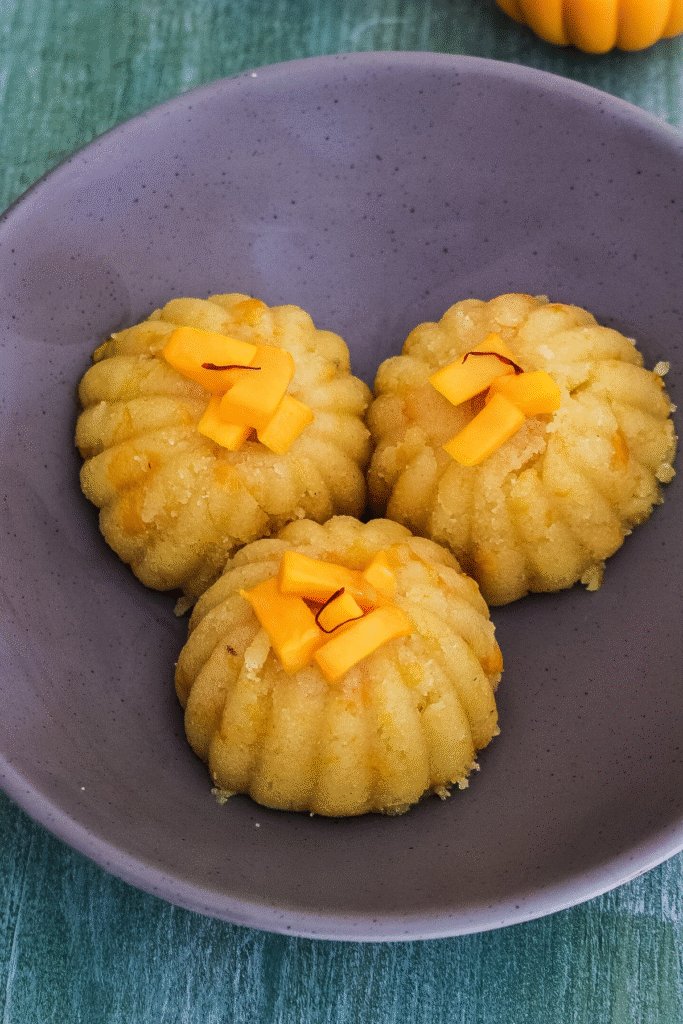Let’s transform the beloved, traditional rava sheera into a summer delight by blending in the luscious sweetness and golden richness of ripe mangoes. This sunny twist adds a burst of tropical flavor, turning an everyday dessert into something truly speci. This delightful twist gives birth to mango sheera—also lovingly known as mango halwa—a dessert that’s bursting with fruity goodness and irresistible aroma. Unlike regular sheera, this version is enriched with the tropical sweetness of mango pulp, creating a soft, melt-in-the-mouth texture that’s both fluffy and indulgent.
The combination of roasted semolina, ghee, and juicy mangoes creates a harmony of flavors that’s perfect for summer indulgence. As the sheera cooks, it soaks up the mango essence, becoming luxuriously smooth and rich. You’ll love the subtle hints of cardamom that balance the sweetness, while a handful of chopped nuts adds just the right crunch to each spoonful.
Whether served warm or slightly chilled, this mango halwa is sure to be the star of your festive table or a cozy weekend treat. It’s an easy-to-make, no-fuss dessert that celebrates the king of fruits in the most comforting way possible. Give your classic sheera a sunny makeover this mango season—you won’t be disappointed!

❤️ About This Mango Halwa Recipe
Taste & Texture:
- Indulge in the delightful flavors of this mango sheera, a pudding-like dessert that perfectly balances sweetness with the tropical richness of ripe mangoes. Each spoonful melts effortlessly in your mouth, offering a smooth, creamy consistency that’s both light and luxurious. The sheera boasts a soft, fluffy body, enriched with ghee and semolina, while tiny bites of fresh, juicy mango chunks surprise your palate with bursts of fruity goodness.
- The sweetness isn’t overpowering — it’s just enough to complement the natural mango flavor and make the dish irresistible. Every bite offers a comforting warmth, enhanced with a hint of cardamom and the golden richness of roasted rava.
- Best of all, this mango halwa comes together quickly — from start to finish, it’s ready in just 25 minutes, making it an ideal last-minute treat. Whether you’re hosting a gathering or simply craving something indulgent yet easy, this mango sheera is a go-to summer dessert that promises to impress.
Velvety, vibrant, and full of mango magic — it’s a seasonal must-make that captures the essence of summer in every spoonful.
🧾 Ingredient Notes For Mango Sheera
- Semolina (Rava or Sooji): Semolina is the heart and soul of this recipe. For the best texture, always opt for fine semolina, which roasts evenly and gives a smooth, creamy consistency to the sheera. The coarse variety—often used for savory dishes like upma, rava dosa, or idli—is not suitable here as it doesn’t yield the soft, pudding-like texture we’re aiming for.
- Sugar: Regular white granulated sugar is used to sweeten the dish. The quantity can be adjusted slightly depending on the sweetness of the mangoes used, but don’t reduce it too much—remember, this is a dessert meant to satisfy your sweet cravings.
- Ghee (Clarified Butter): Ghee is what gives sheera its rich aroma and indulgent taste. Use pure, good-quality ghee, and do not skimp on it! It not only adds richness but also prevents the semolina from becoming sticky. Oil is not a suitable substitute—if you’re thinking of making this vegan, mango sheera might not be the right dessert, because ghee is truly irreplaceable here.
- Milk: Milk is used instead of water to cook the semolina, adding an extra layer of creaminess and making the texture more luxurious. You can use whole milk for maximum richness. It balances the sweetness and pairs beautifully with the fruity mango flavor.
- Mangoes: The star ingredient! Use fresh, ripe, and juicy mangoes that are naturally sweet and fragrant. If you’re in India, nothing beats the taste of Alphonso mangoes (Hapus). In the USA, Ataulfo mangoes are a great alternative thanks to their sweetness and minimal fiber.
- Saffron Strands: A few strands of saffron soaked in warm milk add a luxurious touch. Saffron’s delicate floral aroma complements mango beautifully, making the sheera even more special.
Toss in some golden-roasted cashews and delicate slivers of almonds to bring a delightful crunch and a nutty richness that contrasts beautifully with the dish’s soft, melt-in-the-mouth texture. Not only do they make the sheera more festive, but they also bring in a lovely nutty contrast to the soft semolina base.
👩🍳 How To Make Mango Halwa? (Stepwise Photos)
1) Begin by heating milk in a saucepan over medium-low flame. Let it slowly warm until soft bubbles begin to form on the surface. Avoid boiling it too quickly—slow simmering helps infuse it with a richer flavor and ensures it blends well with the semolina later.
2) Meanwhile, on a separate burner, place a heavy-bottomed pan or kadai over low to medium heat. Add ghee along with semolina (sooji or rava) to the pan. As the ghee melts, it envelops each grain, preparing it for a perfect roast.
3) At this stage, drop in a few strands of saffron—let their fragrant essence and radiant golden color infuse into the warmth, gently awakening the mixture with their luxurious touch. Toss in the chopped nuts of your choice—roasted cashews, slivered almonds, or even pistachios—for an added crunch and rich texture.
4) Continue roasting the semolina while stirring constantly to prevent burning or uneven browning. Initially, the semolina will feel dense and slightly difficult to move through the ghee. As it continues to roast, you’ll notice a transformation—the grains become lighter, airier, and bubbly in texture. A toasty, nutty aroma will begin to fill the kitchen, and the mixture will release ghee from the edges, signaling that it’s perfectly roasted. This stage takes approximately 7 to 8 minutes.
5) Now, gently fold in finely chopped fresh mango pieces. Use ripe, juicy mangoes for the best flavor. Stir them into the roasted semolina mixture.
6) Cook this mango-sooji blend for another 2 to 3 minutes. Stir frequently until the mango pieces soften and begin to break down slightly, with some melting into the mixture, infusing it with a natural sweetness and fruity essence.

7) Slowly pour in the warm milk while continuously stirring the mixture. Be careful during this step, as the hot liquid hitting the pan may cause bubbling or splattering. Stirring continuously will also help prevent the formation of lumps and ensure a smooth texture.
8) Let the mixture gently bubble and cook down, stirring it continuously to ensure a smooth texture and even cooking throughout.. In a few minutes, the semolina will absorb all the milk and thicken up to a soft, pudding-like consistency. This step usually takes around 2 to 3 minutes.
9) Once the mixture has thickened, add sugar. Tailor the quantity to suit the natural sweetness of your mangoes and your individual taste—some mangoes may need less sugar, while others might call for a little more, depending on how ripe and juicy they are. Let your palate guide the balance.
10) As the sugar dissolves, the sheera will momentarily loosen and take on a glossy, syrupy texture. Keep stirring so the sugar integrates fully and doesn’t settle at the bottom.
11) Continue cooking and stirring until the sheera thickens once again. Eventually, it will start pulling away from the sides of the pan. You’ll notice ghee beginning to separate once more and release from the mixture, a sign that the mango sheera is perfectly done and ready to serve.
Serve mango halwa hot or warm. Never served chilled halwa as ghee solidifies after chilling and it doesn’t taste pleasant.

💭 Expert Tips For Best Mango Halwa
- Roasting Sooji (Semolina): This step plays a pivotal role in creating that signature soft and airy texture that truly sets a perfect sheera apart. Take your time with this — roast the semolina patiently over low to medium heat, stirring non-stop. What you want here is a noticeable change — both in the texture turning light and in the aroma becoming rich and nutty.. The grains will become light and airy, turning a gentle golden shade while releasing a warm, nutty fragrance. Proper roasting prevents the final dish from turning sticky or lumpy, so don’t rush this stage.
- Maintain Low to Medium Heat Throughout: Consistency in temperature is the key to evenly cooked, smooth mango sheera. Keep the flame between low to medium for the entire process — from roasting sooji to adding milk, sugar, and mango pulp. If you increase the heat to high at any point, the semolina might brown too quickly on the outside while remaining raw inside. That not only ruins the texture but can introduce a slightly bitter aftertaste.
- Constant Stirring is Non-Negotiable: From the moment you add sooji to ghee, right until the sheera thickens to the desired consistency, you’ll need to give it your full attention. Stirring constantly helps avoid lumps, prevents burning at the bottom, and ensures even cooking. Think of it as a meditative process — put away your phone and focus entirely on your sheera for these few minutes to achieve the perfect outcome.
- Always Use Warm or Hot Milk: The temperature of the milk you add to roasted sooji can significantly impact the texture of your sheera. Cold or room temperature milk causes a sudden drop in temperature, which can shock the mixture and create clumps. To avoid this, always use hot or at least warm milk, which blends smoothly with the roasted semolina and helps it absorb liquid evenly for a luscious, creamy consistency.

